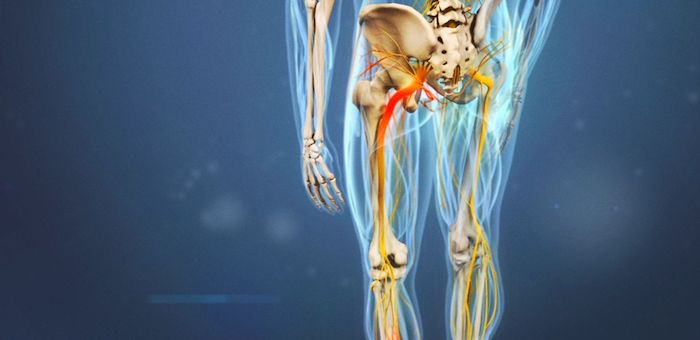
A lumbar herniated disc may cause pain that is described as sharp, burning, or radiating from the lower back, through the buttock, and down the leg (sciatica). Pain relief will look different for everyone and may take trial and error to see a benefit.
Here are 5 little-known tips to help relieve pain and get you on your way to feeling better:
1. Heat and Cold Therapy Can Help Relieve Muscle Tension and Pain.
Applying heat and/or cold therapy to the lower back can alleviate muscle tension that is commonly present with a lumbar herniated disc. The heat helps loosen the muscle tightness that causes spasms, increases blood flow, and improves the elasticity of connective tissue. Cold decreases the local tissue temperature which produces an analgesic and anti-inflammatory effect, thus reducing pain.
- Apply heat to your back in the morning or prior to stretching/exercise to decrease muscle tension.
- Try placing a heating pad or hot compress against your lower back periodically throughout the day. (Make sure to use a physical buffer like a paper towel to avoid thermal injury).
- The same method can be used with a cold pack after stretching, exercise, or massage for pain relief (Make sure to use a physical buffer like a paper towel to avoid thermal injury).
- Other means of heat delivery include adhesive heat wrap (provides continuous, low-level heat over several hours), warm bath, and/or shower at the end of the day.
Try several options and see what works best for you. The type of heat and how you use it is often a matter of personal preference.
2. Moderate Physical Activity Releases Endorphins.
While it may seem counterintuitive, staying active can provide pain relief if you have a lumbar herniated disc. When you exercise the body releases endorphins, which can naturally improve your mood and reduce the perception of pain.
Most people with lumbar herniated discs are able to tolerate low-impact activities such as:
- Walking outside or on a treadmill
- Using an elliptical trainer
- Cycling on a recumbent bicycle
If your pain is more severe, you may want to try a water-based activity, such as hydrotherapy. Water-based activities are often recommended because the buoyancy of water counteracts gravity and decreases the load-bearing placed on your spinal discs. Your health care provider may suggest a dedicated water physical therapy program or swimming.
3. Certain Sleep Positions Help Relieve Herniated Disc Pain.
Pain from a lumbar herniated disc can worsen during the night. You may find comfort sleeping in a position that relieves pressure from the spine. A couple of good options include:
- Use a pillow under your knees to help relieve tension in the lower back.
- Lie on your side with a pillow between your knees to keep your spine straight and hips balanced.
Your preferred sleeping position and pillow placements will likely be determined by the location of your herniated disc. Try a few different pillows and positions to see what works best for you.
4. The McKenzie Method Can Help Shift Sciatica Pain.
The McKenzie Method is one type of physical therapy that involves a specific approach to exercise. For lumbar herniated disc pain, the goal is to shift pain away from your leg (sciatica) and centralize it more in your lower back.
- Your specific symptoms typically determine which McKenzie Method exercises a physical therapist will suggest.
- After your symptoms have moved out of your leg, the approach usually shifts to longer-term rehabilitation to strengthen your back and other key muscle groups.
Even after the lumbar herniated disc pain has subsided, a back strengthening and stretching program should be continued to reduce the risk of lumbar pain returning.
5. Myofascial Release and/or Massage May Help Reduce Pain.
While myofascial pain may not be the original source of lumbar pain, it may be a secondary source of pain originating from a lumbar herniated disc as well as other structures. This can be worsened by poor posture and inactivity. A myofascial release is a form of manual therapy that has been shown to improve low back pain. While postural training and myofascial release can be initiated in physical therapy, there are methods that can be done at home in the meantime.
- Use a lacrosse ball or massage cane to put pressure on tender/trigger points in the lumbar area.
- Once a tender/trigger point is identified, maintain a constant pressure for 1 to 2 minutes to allow for the release of the muscle.
- Repeat these steps for multiple trigger points in the lumbar area.
- This technique may initially worsen pain as pressure is being placed onto inflamed muscles. It is highly recommended to use cold therapy (ice) after myofascial release to reduce pain.
While the pain from most lumbar herniated discs typically resolves in 6 weeks, you will want to manage it in the meantime and take control of your pain management. These tips may not work for everyone, and it may take time before finding what works best to help relieve your lumbar herniated disc pain.
Precision Pain Care and Rehabilitation has two convenient locations in Richmond Hill – Queens and New Hyde Park – Long Island. Call the Richmond Hill office at (718) 215-1888, or (516) 419-4480 for the Long Island office, to arrange an appointment with our Interventional Pain Management Specialist, Dr. Jeffrey Chacko.













